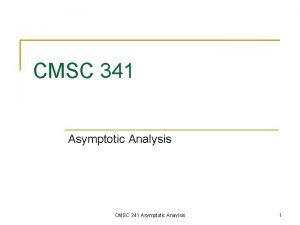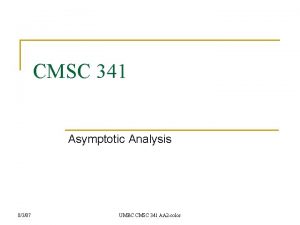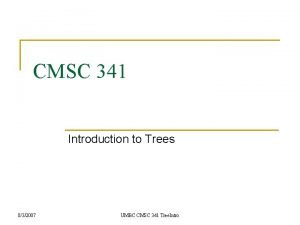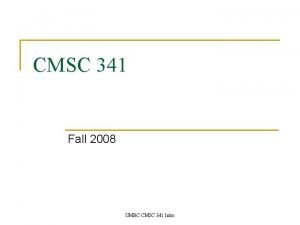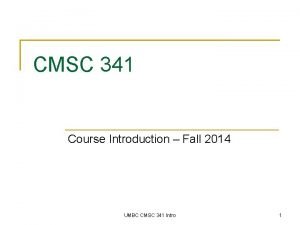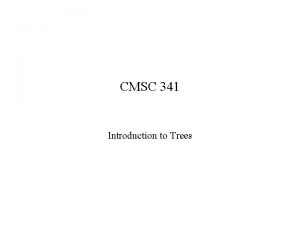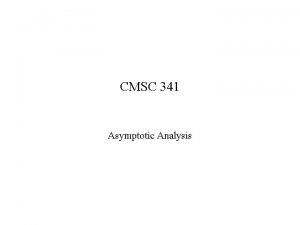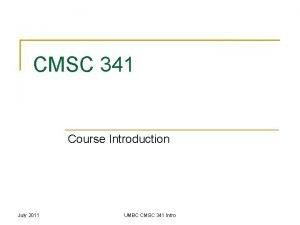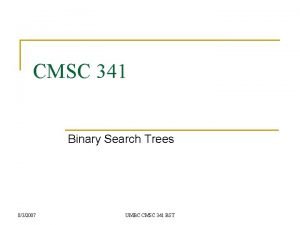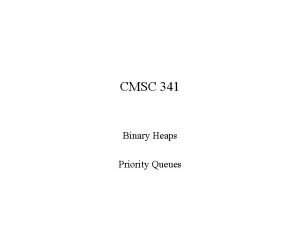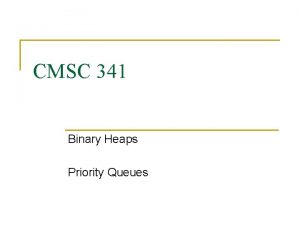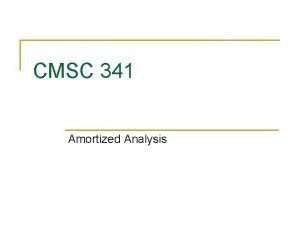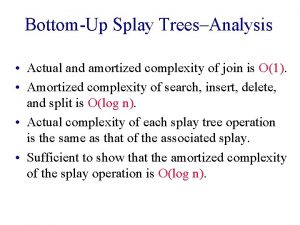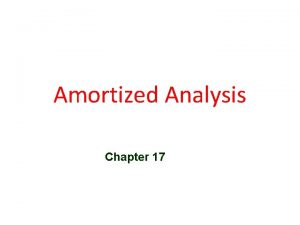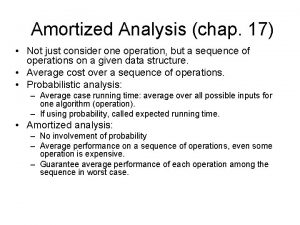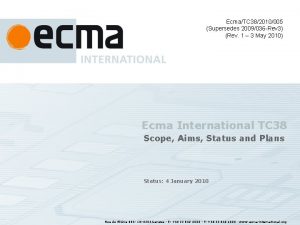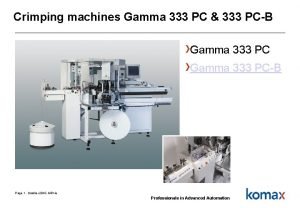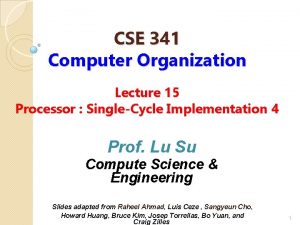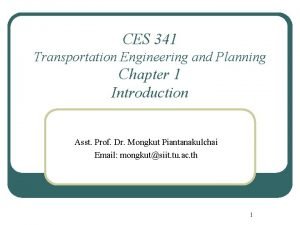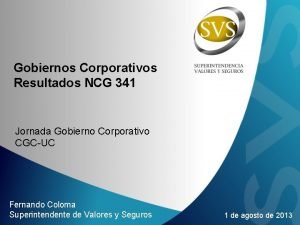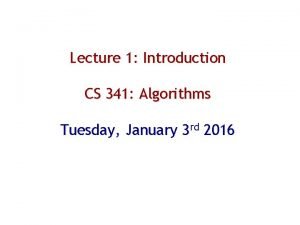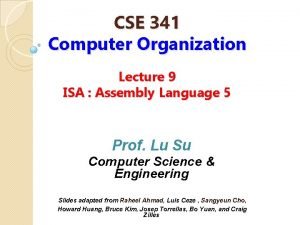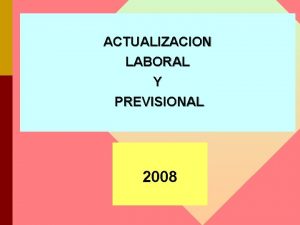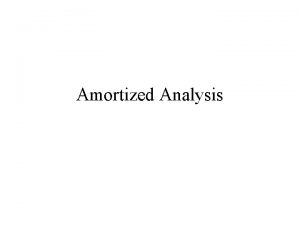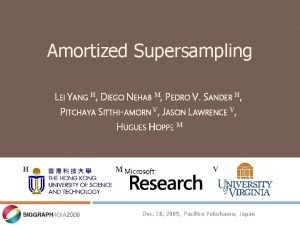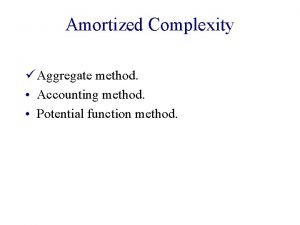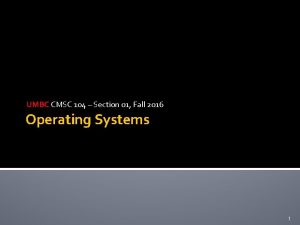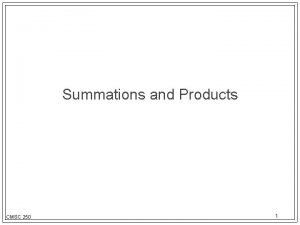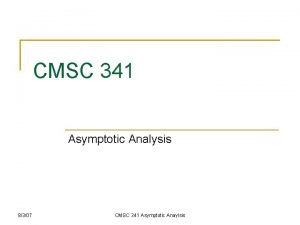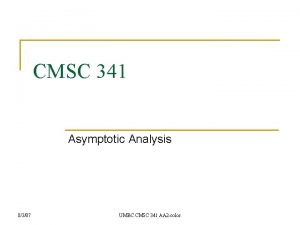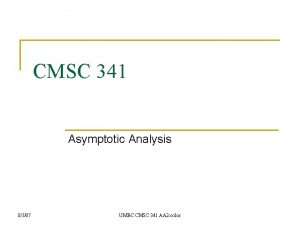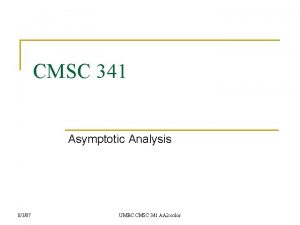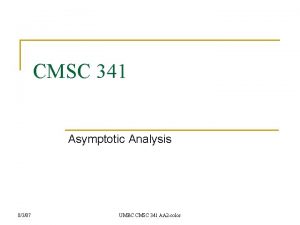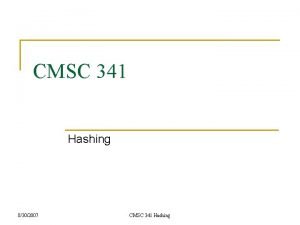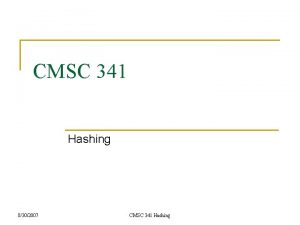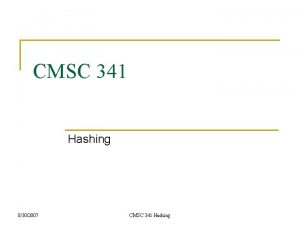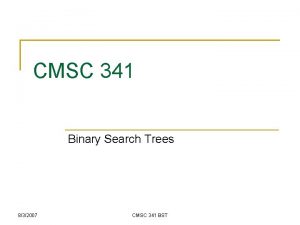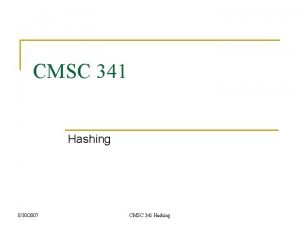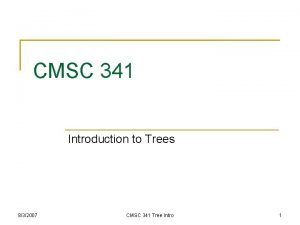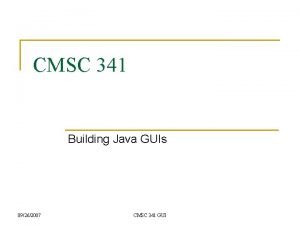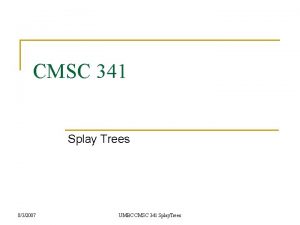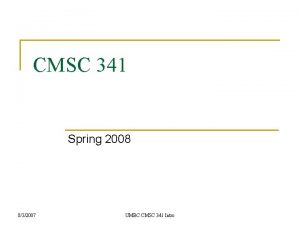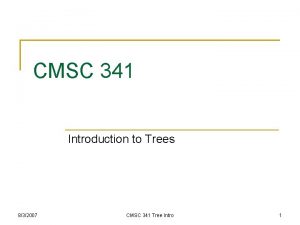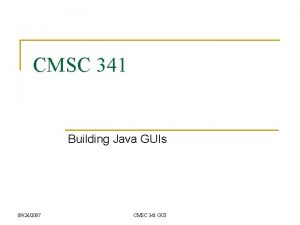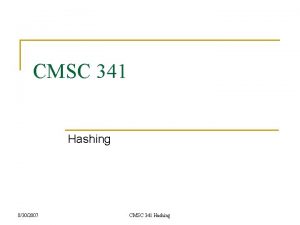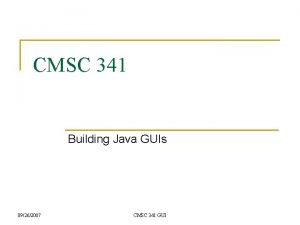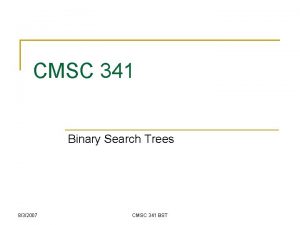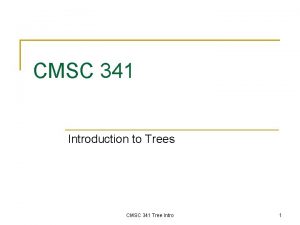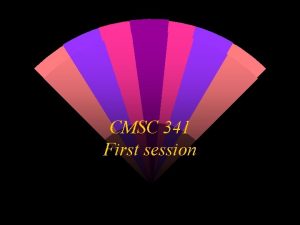CMSC 341 Amortized Analysis What is amortized analysis



































- Slides: 35

CMSC 341 Amortized Analysis

What is amortized analysis? n Consider a sequence of operations on a dynamic data structure q n n Insert or delete in any (valid) order Worst case analysis asks: What is the most expensive any single operation can be? Amortized analysis asks: What is an upper bound on the average per-operation cost over the entire sequence? 10/6/2008 UMBC CMSC 341 Amortized Analysis 2

Nature of the amortized bound n n n Amortized bounds are hard bounds They do not mean “on average (or most of the time) the bound holds” They do mean “for any sequence of n operations, the bound holds over that sequence” 10/6/2008 UMBC CMSC 341 Amortized Analysis 3

Three methods n Aggregate method q q q T(n) = upper bound on total cost of n operations Amortized cost is T(n)/n Some operations may cost more, a lot more, than T(n)/n If so, some operations must cost less But the average cost over the sequence will never exceed T(n)/n 10/6/2008 UMBC CMSC 341 Amortized Analysis 4

Three methods n Accounting method q q q Each operation pays a “fee” (cost of operation) Overcharge some operations and store extra as pre-payment for later operations Amortized cost is (total of fees paid)/n Must ensure bank account never negative, otherwise fee was not high enough and bound does not hold Overpayment stored with specific objects in data structure (e. g. , nodes in a BST) 10/6/2008 UMBC CMSC 341 Amortized Analysis 5

Three methods (cont. ) n Potential method q q q Like accounting method Overpayment stored as “potential energy” of entire data structure (not specific objects) Must ensure that potential energy never falls below zero 10/6/2008 UMBC CMSC 341 Amortized Analysis 6

Increment a binary counter n n A(k-1) A(k-2) 0 0 0 0 A(2) A(1) A(0) 0 0 0 K-bit value stored in array To increment value, flip bits right-to-left until you turn a 0 into a 1 Each bit flip costs O(1) What is the amortized cost of counting from 0 to n? 10/6/2008 UMBC CMSC 341 Amortized Analysis 7

Increment a binary counter n A(k-2) 0 0 0 0 A(2) A(1) A(0) 0 0 0 Worst case q q q n A(k-1) Flip k bits per increment Do that n times to count to n O(kn) But, most of the time we don’t flip many bits 10/6/2008 UMBC CMSC 341 Amortized Analysis 8

Increment a binary counter A(k-1) A(k-2) 0 0 0 0 0 0 Cost A(2) A(1) A(0) 0 0 0 0 1 1 0 0 0 1 1 2 1 0 0 0 1 0 0 3 0 0 0 1 0 1 1 0 0 0 0 1 1 0 2 0 0 0 0 1 1 0 0 0 4 Total: 10/6/2008 UMBC CMSC 341 Amortized Analysis 15 9

Aggregate method n n n A(0) flips every time, or n times A(1) flips every 2 nd time, or n/2 times A(2) flips every 4 th time, or n/4 times A(i) flips n/2 i times Total cost is Σi=0, k-1 n/2 i ≤ Σi=0, ∞n/2 i = 2 n = O(n) So amortized cost is O(n)/n = O(1) 10/6/2008 UMBC CMSC 341 Amortized Analysis 10

Accounting method n n Flipping a bit costs $1 (one unit of computational work) Pay $2 to change a 0 to a 1 q q n Use $1 to pay for flipping the bit to 1 Leave $1 there to pay when/if the bit gets flipped back to 0 Since only one bit gets flipped to 1 per increment, total cost is $2 n = O(n) 10/6/2008 UMBC CMSC 341 Amortized Analysis 11

Accounting method n A(k-1) A(k-2) 0 0 0 $0 $0 $0 A(2) A(1) A(0) 0 0 $0 $0 Flip A(0) to 1 and pay $1 for flip and leave $1 with that bit (total fee of $2) A(k-1) A(k-2) 0 0 0 $0 $0 $0 10/6/2008 A(2) A(1) A(0) 0 0 0 1 $0 $0 $0 $1 UMBC CMSC 341 Amortized Analysis 12

Accounting method n n A(k-1) A(k-2) 0 0 0 $0 $0 $0 A(2) A(1) A(0) 0 0 0 1 $0 $0 $0 $1 Flip A(0) to 0 and pay with the $1 that was there already Flip A(1) to 1 and pay $1 for flip and leave $1 with that bit (total fee of $2) A(k-1) A(k-2) 0 0 0 $0 $0 $0 10/6/2008 A(2) A(1) A(0) 0 0 1 0 $0 $0 $1 $0 UMBC CMSC 341 Amortized Analysis 13

Accounting method n A(k-1) A(k-2) 0 0 0 $0 $0 $0 A(2) A(1) A(0) 0 0 1 0 $0 $0 $1 $0 Flip A(0) to 1 and pay $1 for flip and leave $1 with that bit (total fee of $2) A(k-1) A(k-2) 0 0 0 $0 $0 $0 10/6/2008 A(2) A(1) A(0) 0 0 1 1 $0 $0 $1 $1 UMBC CMSC 341 Amortized Analysis 14

Accounting method n n A(k-1) A(k-2) 0 0 0 $0 $0 $0 A(2) A(1) A(0) 0 0 1 1 $0 $0 $1 $1 Flip A(0) and A(1) to 0 and pay with the $$ that were there already Flip A(2) to 1 and pay $1 for flip and leave $1 with that bit (total fee of $2) A(k-1) A(k-2) 0 0 0 $0 $0 $0 10/6/2008 A(2) A(1) A(0) 0 1 0 0 $0 $1 $0 $0 UMBC CMSC 341 Amortized Analysis 15

Accounting method n n … and so on We “overpay” by $1 for flipping each 0 to 1 Use the extra $1 to pay for the cost of flipping it back to a zero Because a $2 fee for each increment ensures that we have enough money stored to complete that increment, amortized cost is $2 = O(1) per operation 10/6/2008 UMBC CMSC 341 Amortized Analysis 16

Potential method n n Record overpayments as “potential energy” (or just “potential”) of entire data structure Contrast with accounting method where overpayments stored with specific parts of data structure (e. g. , array cells) 10/6/2008 UMBC CMSC 341 Amortized Analysis 17

Potential method n n n Initial data structure is D 0 Perform operations i = 1, 2, 3, …, n The actual cost of operation i is ci The ith operation yields data structure Di Φ(Di) = potential of Di, or stored overpayment Amortized cost of the ith operation is q xi = ci + Φ(Di) - Φ(Di-1) 10/6/2008 UMBC CMSC 341 Amortized Analysis 18

Potential method n If Φ(Di) - Φ(Di-1) > 0 then xi is an overcharge to ith operation q n We paid more than the actual cost of the operation If Φ(Di) - Φ(Di-1) < 0 then xi is an undercharge to the ith operation q We paid less than the actual cost of the operation, but covered the difference by spending potential 10/6/2008 UMBC CMSC 341 Amortized Analysis 19

Potential method n Total amortized cost: q q n Σxi = Σ(ci + Φ(Di) - Φ(Di-1)) = Σci + Φ(Dn) - Φ(D 0) Sum of actual costs plus whatever potential we added but didn’t use Require that Φ(Di) ≥ 0 so we always “pay in advance” 10/6/2008 UMBC CMSC 341 Amortized Analysis 20

Potential method: Binary counter n n Need to choose potential function Φ(Di) Want to make xi = ci + Φ(Di) - Φ(Di-1) small Usually have to be lucky or clever! Let Φ(Di) = bi, the number of ones in the counter after the ith operation q q Note that Φ(Di) ≥ 0 so we’re OK Recall $1 stored with each 1 in the array when using the accounting method 10/6/2008 UMBC CMSC 341 Amortized Analysis 21

Potential method: Binary counter n n Operation i resets (zeroes) ti bits True cost of operation i is ti + 1 q n The +1 is for setting a single bit to 1 Number of ones in counter after ith operation is therefore bi = bi-1 – ti + 1 10/6/2008 UMBC CMSC 341 Amortized Analysis 22

Potential method: Binary counter n n Number of ones in counter after ith operation is bi = bi-1 – ti + 1 Potential difference is q n Φ(Di) - Φ(Di-1) = bi – bi-1 = (bi-1–ti+1) – bi-1 = 1 – ti Amortized cost is q q xi = ci + Φ(Di) - Φ(Di-1) = (ti + 1) + (1 – ti) = 2 If we pay just $2 per operation, we always have enough potential to cover our actual costs per operation 10/6/2008 UMBC CMSC 341 Amortized Analysis 23

Amortized analysis of splay trees n Use the accounting method q n Store $$ with nodes in tree First, some definitions q q Let nx be the number of nodes in the subtree rooted by node x Let rx = floor(log(nx)) n 10/6/2008 Called the rank of x UMBC CMSC 341 Amortized Analysis 24

What we’ll show n n n If every node x always has rx credits then splay operations require amortized O(lgn) time This is called the “credit invariant” For each operation (find, insert, delete) we’ll have to show that we can maintain the credit invariant and pay for the true cost of the operation with O(lgn) $$ per operation 10/6/2008 UMBC CMSC 341 Amortized Analysis 25

First things first n Consider a single splay step q q Single rotation (no grandparent), zig-zig, or zigzag Nodes x, y = parent(x), z = parent(y) rx, ry, and rz are ranks before splay step r’x, r’y, and r’z are ranks after splay step 10/6/2008 UMBC CMSC 341 Amortized Analysis 26

For example (zig-zig case) rz r’x z x ry r’y y rx A 10/6/2008 x D C y A z B B C UMBC CMSC 341 Amortized Analysis r’z D 27

What does a single splay step cost? n To pay for rotations (true cost of step) and maintain credit invariant q q 3(r’x – rx) + 1 credits suffice for single rotation 3(r’x – rx) credits suffice for zig-zig and zig-zag 10/6/2008 UMBC CMSC 341 Amortized Analysis 28

What does a sequence of splay steps cost? n n n As node x moves up the tree, sum costs of individual steps r’x for one step becomes rx for next step Summing over all steps to the root telescopes to become 3(rv – rx) + 1 where v is the root node q q 3(r’x – rx) + 3(r’’x – r’x) + 3(r’’’x – r’’x) … + 1 Note +1 only required (sometimes) for last step 10/6/2008 UMBC CMSC 341 Amortized Analysis 29

The punch line! n 3(rv – rx) + 1 = O(logn) q q n v is root node of tree with n nodes rv = floor(logn) We can splay any node to the root in O(logn) time 10/6/2008 UMBC CMSC 341 Amortized Analysis 30

Single rotation ry r’x y rx A x x C y A B B r’y C To maintain credit invariant at all nodes need to add $Δ • Only rx and ry can change • Δ = (r’x – rx) + (r’y – ry) • Note that r’x = ry so … • Δ = r’y – rx • Note that r’x ≥ r’y so … • Δ = r’y – rx ≤ r’x - rx 10/6/2008 UMBC CMSC 341 Amortized Analysis 31

Single rotation ry r’x y rx A x x C y A B B r’y C To maintain credit invariant at all nodes it suffices to pay $(r’x – rx) • Still need to pay O(1) for the rotation • We allocated 3(r’x – rx) + 1 credits • If r’x > rx we’ve still got 2(r’x – rx) > 1 credits to pay for the rotation • The +1 is there in case r’x = rx • When can that happen? 10/6/2008 UMBC CMSC 341 Amortized Analysis 32

Zig-zig rz r’x z x ry r’y y rx A x D y A C B z B C r’z D To maintain credit invariant at all nodes need to add $Δ • Δ = (r’x – rx) + (r’y – ry) + (r’z – rz) • Note that r’x = rz so … • Δ = r’y + r’z – rx – ry • Note that r’x ≥ r’y and r’x ≥ r’z and rx ≤ ry so … • Δ = r’y + r’z – rx – ry ≤ r’x + r’x – rx = 2(r’x – rx) 10/6/2008 UMBC CMSC 341 Amortized Analysis 33

Zig-zig rz r’x z x ry r’y y rx A x D y A C B z B C r’z D To maintain credit invariant at all nodes it suffices to pay $2(r’x – rx) • Still need to pay O(1) for the rotations • If r’x > rx we can use r’x – rx ≥ 1 credits to pay for the two rotations for a total of $3(r’x – rx) • Otherwise, r’x = rx so r’x = ry = rz • Why? • In this case, we can show that maintaining the invariant frees one or more credits that can be used to pay for the rotations 10/6/2008 UMBC CMSC 341 Amortized Analysis 34

Zig-zag z x y A x B z D A y B C D C • Analysis analogous to zig-zig step • At most $3(r’x – rx) required to maintain invariant and pay for rotations 10/6/2008 UMBC CMSC 341 Amortized Analysis 35
 Cmsc 341
Cmsc 341 Umbc cmsc 341
Umbc cmsc 341 Cmsc 341
Cmsc 341 Umbc cmsc 341
Umbc cmsc 341 Cmsc student portal
Cmsc student portal Cmsc 341
Cmsc 341 Cmsc 341
Cmsc 341 Cmsc 341
Cmsc 341 Cmsc 341 umbc
Cmsc 341 umbc Cmsc 341
Cmsc 341 Cmsc 341
Cmsc 341 Amortized analysis
Amortized analysis Dynamic arrays and amortized analysis
Dynamic arrays and amortized analysis Splay tree amortized analysis
Splay tree amortized analysis Stack analysis
Stack analysis Amortized analysis aggregate method
Amortized analysis aggregate method Amortized analysis
Amortized analysis Sda hymn 341
Sda hymn 341 Ecma-341
Ecma-341 Rounding to ten thousands
Rounding to ten thousands Komax ims 295
Komax ims 295 Jump instruction
Jump instruction 341 ces
341 ces Ck wraps
Ck wraps Oh mon sauveur a toi seul je veux etre
Oh mon sauveur a toi seul je veux etre Mgmt 341
Mgmt 341 Ncg 341
Ncg 341 Cs350 uwaterloo
Cs350 uwaterloo Cse 341
Cse 341 Actualizacion 341
Actualizacion 341 Amortized time complexity
Amortized time complexity What is amortized complexity
What is amortized complexity Amortized supersampling
Amortized supersampling Amortized complexity
Amortized complexity Cmsc 104 umbc
Cmsc 104 umbc Cmsc 250
Cmsc 250
